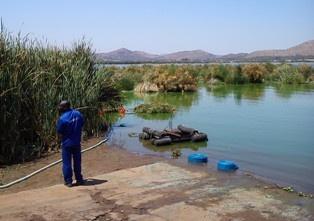At Hartbeespoort Dam in South Africa, journalists within a Finnish-African network were presented with the work of an integrated biological remediation programme, supported by Rand Water and South Africas Department of Water Affairs, and led by DWA programme leader Petrus Venter
Sited in Bojanala District, this is an information facility as well as an environmental initiative. There are workshops, as undertaken for the visiting Finnish-African contingent. The majority of the land in Bojanala is rural, agrarian - but the area is known for platinum mining, too. Further economic benefits derive from tourism - and many of the tourists visiting Bojanala travel to Hartbeespoort Dam to learn about the possibilities for and products of environmental collaboration. A key lesson delivered by the team at the dam is the effect of water resource management on the viability of the region's communities and commercial affairs.
Environmental conditions and concerns
The Finnish interest is very specific, with close support from Lahti in Finland. Lake Vesijarvi in Lahti has similar environmental conditions to Hartbeespoort. The administrative department in Lahti is keen to extend support for environmental projects such as that in Bojanala, and frequently sends students to the dam for water symposiums and bilateral knowledge-building.
Locally, it should be noted, around 4,000 schoolchildren have visited the dam, to see for themselves the test case initiative managed by Petrus Venter's team, entitled 'From Water Desert to Diversity', which delivers an artificial architecture to return original river flows to the area - which had over the century since the dam was built, receded, leading to a loss of diversity of indigenous flora and fauna, and so a loss of wildlife.
"What is desertification? Scientists today would define a desert by depleted diversification," said Mr Venter, who then explained desertification in global terms, observing that our deserts are growing and act as the biggest natural radiators on earth, contributing more than any other factor to the phenomenon of global warming. The science presented by Mr Venter on this matter, to the journalists brought to Hartbeespoort Dam by Finland's Ministry for Foreign Affairs, is convincing. He draws comparisons with Lake Chad, the Sahara, and other similarly challenged areas around the world, to highlight the ways in which poor management of our environment, and so our water, impacts on every conceivable aspect of human existence.
Technical services and scientific expertise
The research presented at the symposiums held at Hartbeesport Dam have proved popular with and useful to non-governmental organisations seeking to learn more about environmental issues in general and water management in particular. Moreover, alongside the symposiums, peer reviews have been conducted in Bojanala along the lines of: efficiency of water resources and management; eutrophication and pollution control; monitoring and laboratory services; and communication and dissemination. These reviews entail exchange of expertise between Finnish and local technicians and academicians, particularly - but also research geared towards progressing the work undertaken for the key programme at the Hartbeespoort Dam, which is called “Harties, metsi-a-me” (“My Water”). The name itself bears the key message delivered by Mr Venter and his team. The water here is “my water” to so many people, for what happens here shows what has been happening to deteriorate water supply in many areas - and also what can happen when the environment is treated positively.





